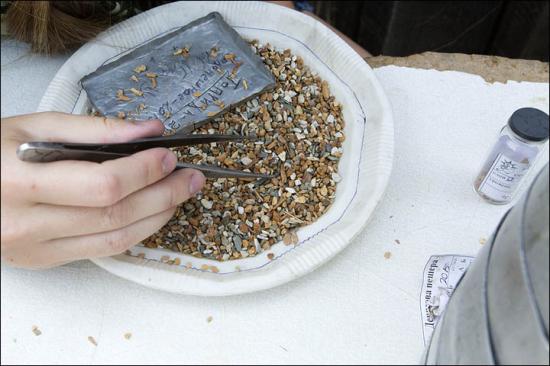PART.2
He explained the way the inside of the cave is divided for the digs to ensure that no precious material is lost, and all clues are understood.
'We divided the area into squares with the size 1x1 metre. Each square we subdivided into two parts. Over there you see that these girls sitting and carefully removing all the ground from the square, layer by layer. Each thin layer is about 4 cm.
'If they see any big find - implements or bones, they leave it in its place, and carefully clean it. We make pictures, draw the location and measure the angle to understand if the find was replaced or moved.

 With the small particles 'the girls sit with tweezers picking the tiny details, including the teeth of rodents, which allow us to determine the climate at that time.' All is marked with the number of layer, square, and year.
With the small particles 'the girls sit with tweezers picking the tiny details, including the teeth of rodents, which allow us to determine the climate at that time.' All is marked with the number of layer, square, and year.
If it lies at an angle to the surface, we suggest that the find and the layer was somehow disturbed. If the finding lies horizontally, we see that the layer was not disturbed. All the measurement we put on excavation site plan, with the exact coordinates. Here no more than two can work. Even for such slim girls there is not so much space here.
'All the ground they put into a bucket together with the label, which indicates the number of the layer and the square. These layers are sent using a special device down to the bank of the Anui River.'
The buckets are send from the cave to the river via the specially designed 'Cableroad' using a device called a Pepelats, initially designed to work at the archaeological site Ust-Karakol-1 by Dr Alexander Postnov. It allows up to nine full buckets to be carried to the opposite river bank 28 metres below the cave.
'On the riverbank we have the 'washing point.' The ground from the buckets is put into the sieves with a different mesh size, so we can divide the big fragments from the small ones,' he said.
Andrey Chekha, junior researcher at the Institute of Archaeology and Ethnography, said big and small fragments are separated. 'From the big fragments, we choose the implements and bones, then clean them once again and mark with the number of layer, square, and year.'
With the small particles 'the girls sit with tweezers picking the tiny details, including the teeth of rodents, which allow us to determine the climate at that time.'
Maksim Kozlikin added: 'For one season, which usually lasts from early June to late August, we dig out not more than three cubic meters of ground. You can see that we are moving very slowly, but this is what allows us to make such a good finds.
'We try not to lose any tiny part. For example, the finger bone of Denisovan girl - it is a very small bone, but we managed to spot it. Also, in our 'jewellery collection' we have beads made of fossilised shells of ostrich eggs. They do not exceed 0.5 cm in diameter. There is a lot of work here. We have almost finished with the famous 11th layer in the central hall and eastern gallery, but it is almost intact in the southern gallery.
'Still, we will finish the eastern gallery and only then will move to the southern. Of course, we are looking forward to new sensational finds related to the Denisovans in 11th layer in the southern gallery, but we cannot just switch from one part of the cave to another, we must work sequentially. Besides, we hope to have interesting finding in the 12th, 13th and 14th layers.
'The cave has an interesting peculiarity, namely that the bones here preserve very well. Because of this, we managed to get the mitochondria DNA from the finger bone dating back 40,000 years. We hope to have good finds in more ancient layers too.'